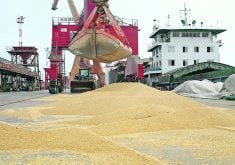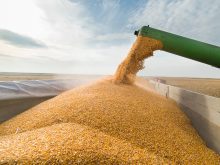ANAHEIM, Calif. — Only a few hands went up when James Mintert asked a room full of farmers if they updated their marketing plans throughout the year.
“That can help you tremendously in your marketing plan and yet it’s something a lot of us don’t do,” said the professor of agricultural economics at Purdue University.
“If you’re not updating your financial plan throughout the year, you’re making a mistake.”
Plans should be revised monthly, or at a minimum quarterly, with updated yield and price estimates. He suggested putting a reminder on the calendar.
Read Also

Flax sector sees omega-3 opportunity
SASKATOON — A global shortage of omega-3 oils could be an opportunity for the flax sector, says an industry official….
Mintert recalled what a big difference he saw in marketing plans between the first week of March 2016 and the third week of June 2016 due to price increases.
“Revenues and projections that looked virtually unattainable in March all of the sudden in June looked very, very feasible,” he told farmers attending the 2018 Commodity Classic.
David Widmar, senior research associate at Purdue University, warned growers not to plug unrealistic yields into their marketing plans.
He noted that soybean yields last year were four bushels per acre above trend line yields and the highest in more than 50 years of data. Corn yields were the second best.
Widmar has never seen a five-year run of above-trend yields like this. If there is a return to average yields, farmers will have to see higher prices to break even in 2018.
Mintert does not think that is in the cards. The theme the last few years has been tough and challenging times and he doesn’t think that will change in 2018.
He said interest rates are still at historically low levels, so he advised farmers to finance debt for as long as possible and to make the smallest down-payments to preserve their working capital.
“Keep that cash available because we’re not forecasting a rosy scenario here,” said Mintert.
Jason Henderson, associate dean of agriculture at Purdue University, said one thing that will likely be different in 2018 is more market volatility after a couple of years of tranquility.
“It’s back,” he said.
That is because money is starting to move around. Part of that is because the U.S. Federal Reserve is starting to shrink its $4.5 trillion balance sheet.
Meanwhile, foreign investors who injected $8 trillion into the U.S. economy in 2016 are starting to take some of that money out.
Henderson said money is increasingly going to be flowing in and out of markets, including agriculture markets, which could lead to temporary bull runs.
“I’m not saying we’re going to see $7 corn. Don’t take it that far,” he said.
Foreign money moving out of the U.S. puts downward pressure on the U.S. dollar. It is already down 10 percent from its highs, which makes U.S. agricultural exports more affordable.
Henderson said a weaker dollar can lead to higher inflation and higher interest rates.
He also noted that there has been surprising strength in the economies of the U.S. and European Union and that should spill over into developing countries, so demand prospects are improving.















